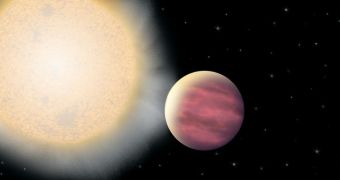A small telescope with a lens no more powerful than that of a small camera managed to discover a distant pair of extrasolar planets that have some unusual properties. The KELT North telescope is located in southern Arizona.
One of the two objects holds great promise towards advancing our knowledge of how star systems evolve, and could even change established theories. The planet is very massive and puffed up, and orbits a very bright star.
Astronomers believe that they could use this world to develop advanced techniques for measuring the atmospheres of distant planets. This is critically important for determining their chemical composition, and establishing whether or not they are theoretically capable of supporting life as we know it.
The findings were made by Thomae Beatty, a PhD student at Ohio State University (OSU), and Robert Siverd, a research scientist at the Vanderbilt University. They presented the findings in Anchorage, Alaska, at the national meeting of the American Astronomical Society, on June 13.
One of the two newly found worlds, called KELT-1b, lies in the constellation Andromeda, whereas the other, KELT-2Ab, can be found in the constellation Auriga. The former is referred to as a failed star, because of its massive size.
KELT-1b is super-hot, super-dense, and made up almost entirely of metallic hydrogen. It is located so close to its massive parent star that it completes a full circle around the latter in less than 30 hours. Astronomers estimate that it receives 6,000 times more radiation than Earth does from the Sun.
Ohio State University associate professor of astronomy Scott Gaudi, a member of the research team, says that this world “resets the bar for weird'.” The second planet, he adds, looks more familiar; astronomers classified it as a hot Jupiter.
“Exoplanets like KELT-1b and KELT-2Ab that pass directly in front of very bright stars are extremely important, but extremely rare, because there just aren’t that many very bright stars in the sky,” VU expert Keivan Stassun adds.
“The KELT-North and KELT-South partnership gives us the advantage of hunting for these rare gems from both hemispheres, doubling the hunting grounds,” he goes on to say. Stassun is a professor of physics and astronomy, and a member of the Vanderbilt Initiative in Data-Intensive Astrophysics.
The Vanderbilt University, NASA and the US National Science Foundation (NSF) provided the funds the team needed to conduct this research.

 14 DAY TRIAL //
14 DAY TRIAL //